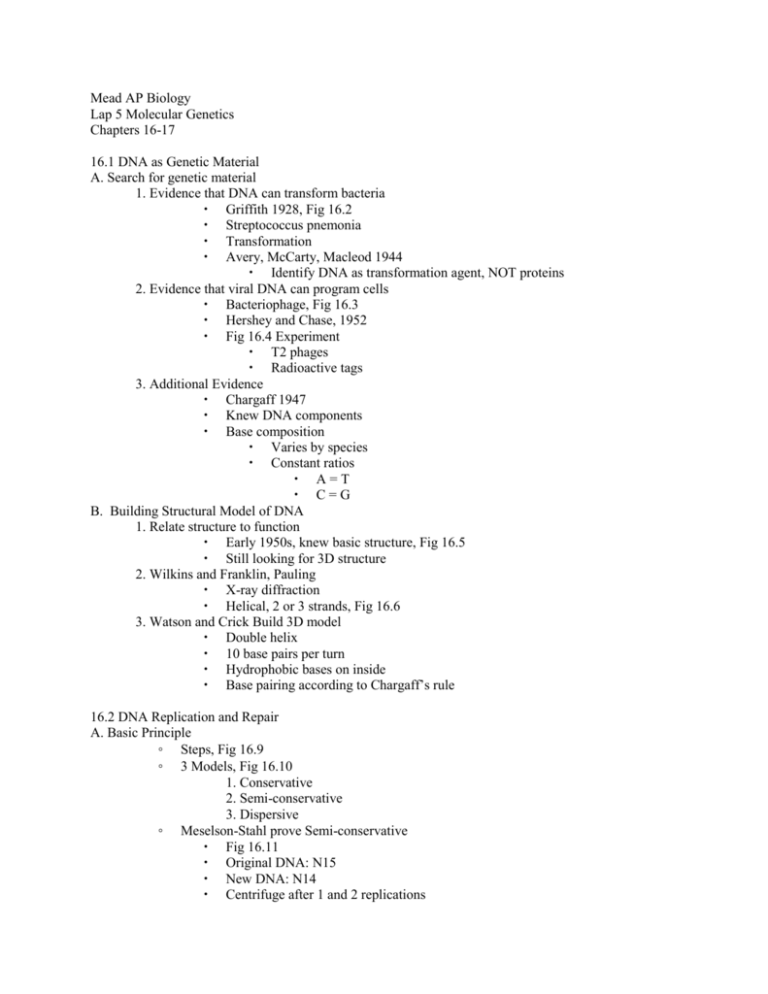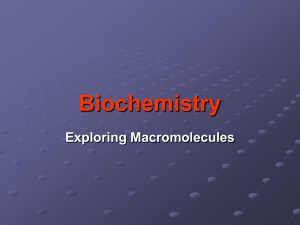Ch 16-17 Oultine - Mead`s Fabulous Weebly
advertisement

Mead AP Biology Lap 5 Molecular Genetics Chapters 16-17 16.1 DNA as Genetic Material A. Search for genetic material 1. Evidence that DNA can transform bacteria Griffith 1928, Fig 16.2 Streptococcus pnemonia Transformation Avery, McCarty, Macleod 1944 Identify DNA as transformation agent, NOT proteins 2. Evidence that viral DNA can program cells Bacteriophage, Fig 16.3 Hershey and Chase, 1952 Fig 16.4 Experiment T2 phages Radioactive tags 3. Additional Evidence Chargaff 1947 Knew DNA components Base composition Varies by species Constant ratios A=T C=G B. Building Structural Model of DNA 1. Relate structure to function Early 1950s, knew basic structure, Fig 16.5 Still looking for 3D structure 2. Wilkins and Franklin, Pauling X-ray diffraction Helical, 2 or 3 strands, Fig 16.6 3. Watson and Crick Build 3D model Double helix 10 base pairs per turn Hydrophobic bases on inside Base pairing according to Chargaff’s rule 16.2 DNA Replication and Repair A. Basic Principle ◦ Steps, Fig 16.9 ◦ 3 Models, Fig 16.10 1. Conservative 2. Semi-conservative 3. Dispersive ◦ Meselson-Stahl prove Semi-conservative Fig 16.11 Original DNA: N15 New DNA: N14 Centrifuge after 1 and 2 replications B. DNA Replication Details 1. Origins of replication, Fig 16.12 Def Initiation proteins recognize and bind Replication “bubble” Replication fork 2. Elongating new strand DNA polymerase Energy provided by 2 phosphate groups Fig 16. 13 3. Antiparallel Elongation ◦ Strands run antiparallel, Fig 16.13 5’ end: phosphate on top ◦ DNA polymerase III adds to 3’ only ◦ Leading strand, Fig 16.14 ◦ Lagging strand Okazaki fragments Ligase 4. Priming DNA synthesis, Fig 16.15 ◦ Need primer Def ◦ Primase ◦ Leading strand: Need 1 ◦ On lagging strand: Need for each Okazaki fragment Replace with DNA by DNA polymerase I Ligase 5. Other proteins assist in replication, Fig 16.16 ◦ Helicase ◦ Single strand binding protein ◦ Topoisomerase 6. Summary, Table 16.1 and Fig 16.16 C. Proofreading and Repairing DNA ◦ Mismatch repair ◦ Repair damage caused by chemical/physical agents ◦ Nucleotide Excision Repair Fig 16.17 Nuclease Polymerase Ligase D. Replicating ends of DNA ◦ DNA polymerase can only add to 3’ Prokaryote: circular DNA no effect Eukaryote: can’t replace primer ◦ Telomeres Def TTAGGG ◦ Telomerase Enzyme function Germ cells Link to aging Cancer 17.1 Genes Specify Proteins A. Evidence from the study of metabolic disorders ◦ 1909 Garrod: Genes dictate phenotypes through enzymes Alkaptonuria ◦ 1930s: Fruit fly eye color ◦ Beadle and Tatum: Work with bread mold to create one gene-one enzyme hypothesis Metabolic pathway needed to make amino acids Precursor Ornithine Citrulline Arginine A B C Each reaction catalyzed by an enzyme If mutation at A: must add Orn If mutation at B: must add Cit B. Basic principles of Transcription and Translation Fig 17.3 1. Genes (DNA) provide instructions for proteins 2. RNA connects DNA to protein RNA structure 3. Transcription: synthesis of mRNA 4. Translation: synthesis of polypeptide chain RNA base sequence to amino acid sequence tRNA rRNA 5. Eukaryotic cells add RNA processing: make pre mRNA C. The Genetic Code ◦ Codons: triplets of bases ◦ DNA template mRNA codon amino acids: Fig 17.4 ◦ Cracking the code, Fig 17.5 Deciphered by mid 1960s Start/methionine: AUG Stop: UAA / UAG / UGA Multiple versions of each amino acid keep error low “Reading frame” D. DNA code evolution ◦ Nearly universal ◦ Transplant genes between species ◦ Fig 17.6: firefly gene inserted into tobacco ◦ Uses 17.2 Transcription: Details A. RNA polymerase ◦ Function ◦ Transcription unit ◦ Bacteria vs Eukaryote ◦ Promoter In Euk: TATA box B. 3 Stages of Transcription, Fig 17.7 Initiation, Fig 17.8 Transcription factors recognize TATA promoter RNA polymerase Transcription initiation complex Elongation, Fig 17.7 Termination Prokaryotes Terminator sequence End of transcription unit End of gene Release mRNA and RNA polymerase Eukaryotes Polyadenylation sequence AAUAAA RNA polymerase releases later Move on to RNA processing 17.3 Eukaryotic cells modify RNA A. Alteration of mRNA ends, Fig 17. 9 ◦ 5’ cap: Modified Guanine ◦ Poly-A tail ◦ Functions B. Split genes and RNA splicing ◦ RNA splicing ◦ Exons and Introns ◦ Introns removed ◦ Spliceosomes, Fig 17.11 snRNP and proteins ◦ Ribozymes ◦ Importance of Introns 17.4 Translation: Details A. Translation: Overview ◦ Fig 17.13 B. Molecules involved in translation ◦ Transfer RNA, Fig 17.14 tRNA Anticodon Unique for each amino acid Structure tRNA “wobble” ◦ Aminoacyl-tRNA synthetase, Fig 17.15 Uses ATP for energy ◦ Ribosomes, Fig 17.16 2 subunits Structure: Binding sites 1 for mRNA and 3 for tRNA: E,P, A Function C. 3 Steps of Building a Polypeptide 1. Initiation, Fig 17.17 Create Translation Initiation Complex Small ribosomoal subunit mRNA Initiator tRNA (methionine): into P site Large ribosomal subunit Initiation factors (proteins) bring it all together Requires GTP for energy 2. Elongation, Fig 17.18 Codon recognition: A site Peptide bond formation Translocation Requires elongation factors Requires energy: GTP 3. Termination, Fig 17.19 Stop codon reaches P site Release factor enters A site Breaks bond of tRNA in P site and last amino acid Components disassemble Polyribosomes, Fig 17.20 Simultaneous translation D. Completing and Targeting Protein ◦ Folding and Modifications ◦ Targeting to specific locations Fig 17.21 Start translation in a free cytoplasmic ribosome SRP halts translation Moves to ER 17.5 RNA Roles in Cell: Table 17.1 17.6 Point Mutations Affect Protein A. Point mutation ◦ Def ◦ Types Substitutions, Fig 17.24 Silent Missense Nonsense Example: Sickle Cell Anemia, Fig 17.23 Insertion/Deletion Fig 17.25 Frame-shift mutations B. Mutagens ◦ Spontaneous mutations ◦ Mutagens def ◦ Ames test Summary of transcription and translation, Fig 17.26






